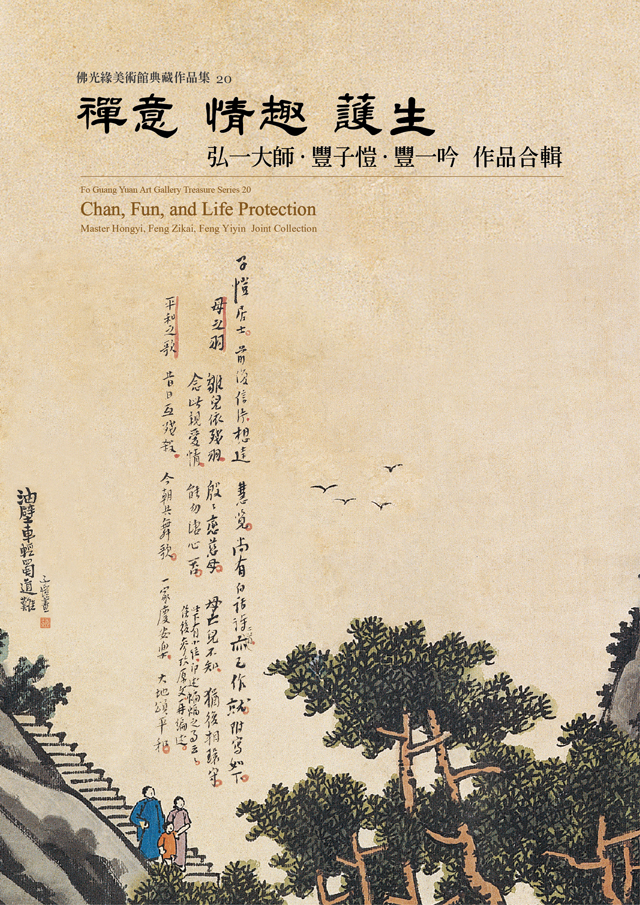 護生是佛陀本懷
護生是佛陀本懷
佛光山佛陀紀念館館長 如常
本典藏作品集收錄有弘一大師的書法、豐子愷的書畫及豐一吟的畫作。出版前翻閱這些作品,感受特別深,因為佛陀紀念館風雨走廊外牆面上的「護生圖」浮雕,就是取材自此。現在每當我看到這些「護生圖」,總會不由自主的穿越時空憶起釋迦牟尼佛,想起弘一大師和豐子愷、豐一吟居士,想到星雲大師……
二千六百年前,釋迦牟尼佛於菩提樹下,初成正覺,證悟了宇宙人生的實相。他第一句話即說:「奇哉!奇哉!大地眾生,皆具如來智慧德相,但因妄想執著,而不能證得。」釋迦牟尼佛一語道破,所有眾生都是平等無異,皆有佛性,都可以成佛。
一九二八年豐子愷居士為祝弘一大師五十壽,繪護生畫五十幅,由弘一大師題詩,十年之後,豐子愷依前例以六十幅護生畫為師祝壽,弘一大師仍為畫題詞。弘一大師圓寂後,豐子愷陸續創作,至弘一大師百歲冥誕,共計繪製四百五十幅圖文,編為六冊,名為《護生畫集》,豐子愷在序文中說明:「護生者,護心也。」「去除殘忍心,長養慈悲心,然後拿此心來待人處世。」
一九六七年,星雲大師開創佛光山,致力推動「人間佛教」。大師於〈佛教對環保問題的看法〉一文中提到:「護生,可以長養慈悲心。……佛教提倡不殺生而積極護生,戒殺護生,就是對一切有情生命的尊重,所以佛教的戒律對於動物的保護,有著積極的慈悲思想。」
記得有一回,我帶一對母子欣賞佛館的護生圖,大約七歲的兒子不期然的佇足在「螞蟻搬家」圖前面,用他那稚嫩的童音念道:「牆根有群蟻,喬遷向南岡。元首為嚮導,民眾扛饌糧。浩蕩復迤邐,橫斷路中央。我為取小凳,臨時築長廊。大隊廊下過,不怕飛來殃。」這當中,有他不認得的字,但他並沒有中斷,一口氣念完。媽媽為兒子解釋畫意,兒子聽得出神,許久才認真的說道:「以後我們家的螞蟻要搬家,媽咪也要為牠們蓋一座長廊。」媽咪笑而不答,兒子又說了一遍,媽咪若有所思,兒子不放過,再說了一遍,媽咪點點頭,兒子不放心的又重複說了一遍,媽咪用力點頭,大聲說「好!」兒子開懷的笑了……
望著他們母子離去的背影,讓我想起曾經在網路上看到的一則短片,片中描述一個葡萄牙小男孩正準備用餐,他看著盤子裡的章魚麵疙瘩遲遲不肯動叉子,他天真地問:「章魚不是真的吧?」聽完媽媽的解釋以後,小男孩還一度以為章魚的頭還存活在海裡。直到媽媽告訴小男孩,所有的動物在端上餐桌之前都會被人切開,小男孩才終於搞清楚狀況。他驚訝地說:「所以……我們吃動物的時候,牠們會死!這些動物……妳應該照顧牠們,不應該吃掉牠們!」媽媽聽了,感動得流下了淚。
本書除了護生畫,弘一大師書法的作品包括《華嚴經》偈頌、護生詩,及他寫給豐子愷的書信等。而豐子愷和豐一吟父女的作品,則是詩中有畫,畫中有詩,讓讀者不僅欣賞文學,同時感受藝術之美。這些作品所呈現的都是佛陀的本懷,是最好的生命教育,更是人間佛教的體現。
Protecting Life is the Original Intent of the Buddha
Director FGS Buddha Museum Shi Ru Chang
This album is a compilation of Master Hongyi’s calligraphy, Feng Zikai’s paintings, and Feng Yiyin’s artworks. Before releasing this book, I browsed through these artworks and felt a deep connection with the works. The exterior sides of the covered walkways at the Buddha Memorial Center (BMC) are sculpted with the reliefs of the Life Protection Murals. Whenever I see these murals, the images of Sakyamuni Buddha, Master Hongyi, Feng Zikai, Feng Yiyin, and even Venerable Master Hsing Yun would come to my mind.
Two thousand six hundred years ago, Sakaymuni Buddha became enlightened under the Bodhi tree. His first words were, “How rare! How rare! All sentient beings possess the wisdom and virtues of a Tathagata, but have yet to attain enlightenment because of their delusions and attachments.” These words point out the fact that all lives are equal in their Buddha nature. They could all become enlightened. In 1928 when Master Hongyi celebrated his 50th birthday, Feng Zikai gifted the Master 50 pieces of artwork from his own collection. The inscriptions on these artworks were later penned by Master Hongyi. Ten years later, Feng Zikai gifted Master Hongyi with another 60 pieces of artwork to celebrate his 60th birthday. The inscriptions on these artwork were again penned by Master Hongyi. After Master Hongyi passed away, Feng Zikai continued to create art. By Master Hongyi’s 100th posthumous birthday, Feng Zikai had created 450 pieces of art, and compiled them into a six-volume Protecting Lives Collection. Feng Zikai mentioned in his preface that, “Those who protect lives, protect their own hearts”… “Be rid of cruelty, let compassion grow, and treat others with compassion.”
When Venerable Master Hsing Yun built Fo Guang Shan in 1967, he started promoting Humanistic Buddhism. His views toward the environment were “protecting lives allows one’s compassion to grow… Buddhism advocates the ideas of no killing and protecting lives. Refraining from killing and protecting lives is a way to show respect for all sentient beings. And thus, Buddhist precepts play a proactive role in protecting animals.”
Once I guided a mother and son when they visited the BMC. The seven-year-old son arrived at the mural depicting Ants Move Home. He clumsily read out the words:
A group of ants at the foot of the wall was moving to the southern hill,
The leader acted as the guide while the commoner ants carried their food and rations,
They formed a long line that extended a long way, cutting across the middle of the road.
I moved small benches to cover their trail, and built a temporary veranda for them.
The ants moved underneath the veranda, fearless of anything untoward or calamitous.
Even though he did not recognize the characters, he still managed to finish reading. His mother explained what the words meant. Her son was fascinated by this concept and after a while declared, “Mommy, when our ants want to move house, you have to build a veranda for them!” His mother only smiled. He repeated his words and she nodded, but her son was adamant and repeated it a third time. This time she replied, “All right!” The boy was mollified and beamed with joy.
As I watched them leave, the incident brought back memories of a short video that I had seen online. The video showed a Portuguese boy who was at a dining table. When he saw the octopus on his plate, he refused to eat and asked, “This octopus isn’t real, right?” After his mother explained the concept to him, he asked if the octopus was still living in the ocean with only its head. When his mother explained that animals consumed by humans will be killed, the boy finally understood. He exclaimed, “So…all the animals we eat will die! These animals…we shouldn’t eat them, we should be protecting them!” When his mother heard this, she wept.
Apart from the Protecting Lives Collection, other pieces include verses from the Avatamsaka Sutra, Protecting Lives Poetry, and letters that Master Hongyi wrote to Feng Zikai. Artworks by Feng Zikai and his daughter, Feng Yiyin, integrate both poetry and painting, allowing the viewer to admire both art forms at the same time. These artworks are representations of the original intentions of the Buddha. They are ideal educational resources about valuing life and epitomize Humanistic Buddhism.
